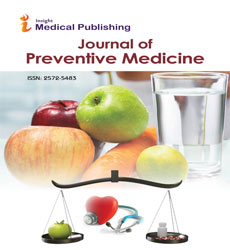Nutritional Interventions in Population Health: Evidence-Based Preventive Strategies
Jemma Breanna
Department of Internal Medicine I, University Hospital Regensburg, 93053 Regensburg, Germany
Published Date: 2025-02-24*Corresponding author:
Jemma Breanna,
Department of Internal Medicine I, University Hospital Regensburg, 93053 Regensburg, Germany,
E-mail: Breanna.jem@stud.uni-regensburg.de
Received date: 03 February, 2025, Manuscript No. ipjpm-25-20407; Editor assigned date: 05 February, 2025, PreQC No. ipjpm-25-20407 (PQ); Reviewed date: 10 February, 2025, QC No. ipjpm-25-20407; Revised date: 17 February, 2025, Manuscript No. ipjpm-25-20407 (R); Published date: 24 February, 2025, DOI: 10.36648/2572-5483.10.1.273
Citation: Breanna J (2025) Nutritional Interventions in Population Health: Evidence-Based Preventive Strategies. J Prev Med Vol.10 No.1: 273.
Introduction
Nutrition plays a pivotal role in determining health outcomes across populations. Poor dietary habits are a leading cause of Chronic Non-Communicable Diseases (NCDs) such as cardiovascular diseases, diabetes, obesity and certain cancers. As modern societies continue to struggle with increasing rates of these conditions, attention has shifted toward preventive strategies that emphasize nutrition. Public health systems worldwide are increasingly recognizing the need for population-wide nutritional interventions that are both evidence-based and scalable. These strategies aim not only to reduce disease burden but also to enhance quality of life, support healthy aging and reduce healthcare expenditures. Integrating sound nutritional practices into population health planning is no longer optional it is a necessity for sustainable and equitable health development [1].
Description
Nutrition as a determinant of health extends beyond individual dietary choices. It encompasses food systems, socio-economic factors, cultural preferences, education and public policy. Nutritional interventions at the population level aim to shift the dietary behaviors of communities and nations toward healthier patterns. Such interventions can be broadly categorized into educational strategies, food environment modifications, policy-level actions and targeted supplementation or fortification programs.
One of the most widely implemented nutritional interventions is public education and awareness campaigns. These initiatives focus on informing the public about the health risks associated with unhealthy diets and the benefits of balanced nutrition. Mass media, school programs and community-based workshops have been used effectively to disseminate these messages. Evidence suggests that when well-designed and culturally tailored, educational interventions can lead to significant behavioral changes at the population level. However, education alone may not be sufficient to bring about long-lasting change, especially in environments where unhealthy foods are more accessible or affordable than nutritious options. Therefore, modifying the food environment is essential.
This involves creating settings such as schools, workplaces and public institutions where healthy food choices are available, affordable and convenient. For instance, policies mandating healthier school meals, restricting the sale of sugary drinks on public premises, or incentivizing supermarkets to operate in underserved communities can promote better dietary choices. Urban planning that includes access to fresh food markets and community gardens also supports this approach. Government regulation and policy-making form another critical pillar of nutritional intervention. Evidence-based policies can have far-reaching effects when strategically implemented. Examples include taxation on sugar-sweetened beverages, mandatory front-of-package labeling, restrictions on junk food advertising to children and food reformulation initiatives that require manufacturers to reduce unhealthy ingredients.
The implementation of these policies has shown promising outcomes in countries like Mexico, where soda taxes led to reduced consumption, or in the UK, where mandatory salt reduction targets influenced manufacturers and improved public health outcomes. Fortification and supplementation programs target specific nutrient deficiencies that are prevalent in certain populations [2].
These deficiencies such as iodine, iron, folic acid and vitamin D can lead to serious public health issues, especially among vulnerable groups like pregnant women, children and the elderly. Fortifying staple foods, such as adding iodine to salt or folic acid to flour, has proven highly effective in reducing the prevalence of conditions such as goiter and neural tube defects. These strategies are cost-effective and scalable, making them ideal for low- and middle-income countries facing widespread micronutrient deficiencies. Nutritional interventions can also be tailored to address emerging global health challenges such as obesity and metabolic syndrome. The shift toward high-calorie, low-nutrient diets has been linked to an increase in non-communicable diseases in both developed and developing countries. Tackling this issue requires a multi-pronged approach that includes not just health education and environmental changes, but also policies that address food marketing, portion sizes and consumer incentives. Programs that provide financial subsidies for purchasing fresh produce or that integrate nutrition services into primary healthcare are examples of how nutritional interventions can be aligned with broader health systems.
Conclusion
Nutritional interventions represent a cornerstone of evidence-based preventive strategies in population health. By addressing the root causes of diet-related diseases and promoting healthier food environments, these interventions have the potential to significantly improve health outcomes across diverse populations. Effective strategies range from public education and food policy reforms to targeted nutrient supplementation and community-based programs. Equity, cultural relevance and sustainability are key principles that must guide the design and implementation of such efforts. In an era where preventable diseases are among the top causes of mortality and morbidity, investing in nutrition is not only a matter of public health it is a powerful tool for social and economic development. Ensuring that every individual has access to nutritious food and the knowledge to make healthy choices is a shared responsibility and a critical step toward achieving global health goals.
Acknowledgement
None.
Conflict of Interest
None.
References
- Thanasuwat B, Leung SOA, Welch K, Duffey-Lind E, Pena N, et al. (2022) Human Papillomavirus (HPV) education and knowledge among medical and dental trainees. J Cancer Educ : 1-6.
Google Scholar Cross Ref Indexed at
- Bencherit D, Kidar R, Otmani S, Sallam M, Samara K, et al. (2022) Knowledge and awareness of algerian students about cervical cancer, HPV and HPV vaccines: A cross-sectional study. Vaccines (Basel) 10: 1420.
Open Access Journals
- Aquaculture & Veterinary Science
- Chemistry & Chemical Sciences
- Clinical Sciences
- Engineering
- General Science
- Genetics & Molecular Biology
- Health Care & Nursing
- Immunology & Microbiology
- Materials Science
- Mathematics & Physics
- Medical Sciences
- Neurology & Psychiatry
- Oncology & Cancer Science
- Pharmaceutical Sciences
